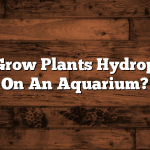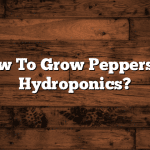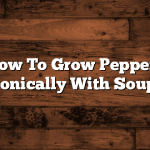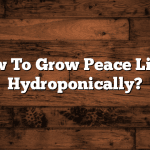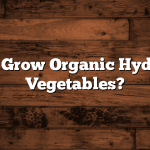Understanding the Growth Cycle of Hydroponic Tomatoes
Growth cycle of hydroponic tomatoes plays a crucial role in determining their yield and quality. Understanding this cycle is essential for successful cultivation. The growth cycle of hydroponic tomatoes can be divided into several stages, starting from seedling establishment to fruit ripening.
The first stage is the seedling stage, where seeds are germinated and young plants are established. During this stage, the roots start developing and the plants begin to produce their first true leaves. This stage usually lasts for about 1-2 weeks, depending on the variety and environmental conditions. It is important to ensure optimal temperature, humidity, and nutrient levels during this stage to promote healthy root and leaf development. Once the seedlings are well-established, they can be transplanted into the main growing system for further growth and development.
Factors Affecting the Growth Rate of Hydroponic Tomatoes
When it comes to hydroponic tomato cultivation, several factors play a crucial role in determining the growth rate of the plants. One of the primary factors is light. Tomatoes require at least 12-14 hours of light each day for optimal growth. Insufficient light can lead to stunted growth and lower fruit production. Therefore, it is essential to provide artificial lighting, such as high-quality LED grow lights, to ensure that the plants receive the required amount of light.
Another significant factor that affects the growth rate of hydroponic tomatoes is nutrient availability. As these plants are grown in a controlled environment, it is vital to provide them with the proper balance of nutrients to thrive. Hydroponic systems use nutrient solutions that contain essential elements like nitrogen, phosphorus, and potassium, along with micronutrients. Monitoring and adjusting the nutrient solution’s strength and pH levels is crucial to ensure that the plants receive the right amount of nutrients at all growth stages. Proper nutrient management is essential for healthy foliage, robust root development, and the production of high-quality tomatoes.
Choosing the Right Hydroponic System for Tomato Cultivation
Among the many crucial decisions that hydroponic tomato cultivators face, one of the most important is choosing the right hydroponic system. The choice of system can significantly impact the growth and productivity of tomatoes. There are several factors to consider when selecting a hydroponic system for tomato cultivation.
First and foremost, the size of the hydroponic system plays a vital role. The system must be able to accommodate the number of tomato plants you plan to grow. Whether you are a commercial grower or a hobbyist, it is crucial to choose a system that matches your desired scale of production. Additionally, the available space for installing the hydroponic system should be taken into account. It is essential to choose a system that fits well within your designated area.
Secondly, the type of hydroponic system should be carefully considered. Various types of systems are available, such as nutrient film technique (NFT), deep water culture (DWC), and nutrient drip systems, among others. Each type has its own advantages and disadvantages. For example, NFT systems provide an efficient use of water and nutrients but require vigilant monitoring to prevent clogging. On the other hand, DWC systems are easier to set up and maintain but may lead to greater water consumption. By thoroughly researching and understanding the characteristics of each system, you can make an informed decision based on your specific needs and constraints.
Selecting the Best Tomato Varieties for Hydroponic Growing
When it comes to selecting the best tomato varieties for hydroponic growing, there are several factors that need to be taken into consideration. First and foremost, it is important to choose varieties that are well-suited for indoor cultivation and have a compact growth habit. These varieties will be able to thrive in the limited space provided by hydroponic systems.
In addition to growth habit, it is also crucial to select tomato varieties that have a high yield potential and are disease-resistant. This will ensure that you can maximize your crop production while minimizing the risk of plant diseases. Some popular disease-resistant tomato varieties for hydroponic growing include ‘Celebrity,’ ‘Mountain Pride,’ and ‘Crimson Crush.’ Furthermore, it is a good idea to choose varieties that have a relatively short maturity period, as this will allow you to harvest your tomatoes sooner.
In conclusion, selecting the best tomato varieties for hydroponic growing requires careful consideration of factors such as growth habit, yield potential, disease resistance, and maturity period. By choosing varieties that meet these criteria, you can enhance the success of your hydroponic tomato cultivation and enjoy a bountiful harvest.
Preparing the Hydroponic Setup for Tomato Cultivation
To set up a successful hydroponic system for tomato cultivation, several key steps must be followed. Firstly, it is crucial to thoroughly clean and disinfect all equipment that will be used, including the nutrient reservoir, irrigation lines, and growing containers. This helps prevent the introduction of any pathogens or pests that could hinder plant growth. Additionally, it is important to ensure that the system is properly assembled and all components are securely in place. This includes checking for any leaks or malfunctions that could disrupt the flow of water and nutrients to the plants. Taking the time to prepare the hydroponic setup adequately will create a stable environment for the tomatoes to thrive in.
Next, the nutrient solution must be properly mixed and adjusted to meet the specific needs of tomato plants. This involves carefully measuring out the appropriate amounts of each nutrient element, such as nitrogen, phosphorus, and potassium, and ensuring the solution has the correct pH level. It is recommended to use high-quality nutrient solutions specifically formulated for hydroponic tomato cultivation to ensure optimal results. Once the nutrient solution is prepared, it should be constantly monitored and adjusted as necessary throughout the growing cycle to maintain the ideal nutrient balance for the tomatoes. This level of attention to detail in preparing the hydroponic setup will lay the foundation for healthy and productive tomato plants.

